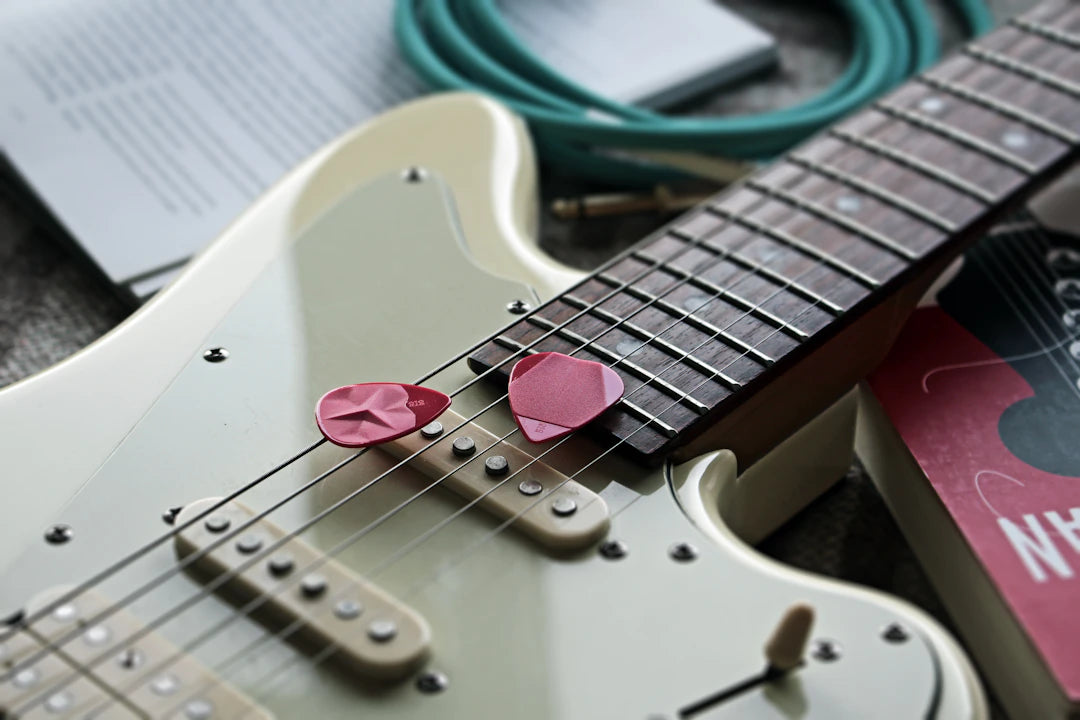Overview
Learn how to protect your painted guitar from damage through understanding risks, creating a stable environment, using physical protection, and maintaining regular cleaning habits. Adopting mindful playing practices and investing in protective accessories can also enhance its longevity and sound quality.
Frequently Asked Questions
1. What are the common risks that can damage my painted guitar?
2. How can I create a stable environment for my guitar?
3. What physical protection measures should I take for my guitar?
4. How should I clean and maintain my painted guitar?
5. What mindful playing habits can help protect my guitar?
Your guitar is more than just an instrument; it's an extension of your creativity and passion. When you've invested time and love into a beautifully painted guitar, protecting it from damage becomes a priority. In this article, we'll explore various methods to safeguard your painted guitar, ensuring it maintains its aesthetic appeal and sound quality for years to come.
Understanding the Risks
Before diving into protective measures, it’s important to understand the common risks that can damage your painted guitar. These threats range from environmental factors to everyday handling. Here are some main culprits:
- Humidity and Temperature Changes: Fluctuations in humidity and temperature can cause the wood to expand or contract, potentially leading to cracks or separation.
- Physical Scratches and Dings: Whether from accidental bumps or regular handling, physical damage can mar the finish of your guitar.
- Sunlight Exposure: Prolonged exposure to sunlight can fade the paint and damage the finish, affecting both appearance and sound.
- Improper Cleaning: Using the wrong cleaning agents or techniques can strip your guitar’s finish or leave unsightly residues.
Choosing the Right Environment
Creating an optimal environment for your guitar is one of the first steps you can take to protect it. Here are some tips on managing its surroundings:
Stable Temperature and Humidity
Ideally, your guitar should be kept in a room with stable temperature and humidity conditions. A range around 70°F and 40-60% humidity is considered safe. If you live in a climate that fluctuates significantly, using a hygrometer can help you monitor these conditions. A dehumidifier or humidifier may also be necessary during extreme weather to maintain a safe environment.
Avoid Direct Sunlight
Keep your guitar away from windows or direct sunlight, which can fade the paint and harm the lacquer. If you need to store it in a sunny spot, consider investing in protective covers or cases that shield your guitar from UV rays.
Physical Protection Techniques
In addition to creating a conducive environment, using physical barriers can greatly reduce the risk of damage to your guitar. Consider these protective measures:
Use a Quality Gig Bag or Case
Transporting your guitar can be risky. Always use a high-quality gig bag or hard case when you're on the move. Look for cases with padded interiors to prevent scratches and dings during transit. A solid case also offers protection from environmental elements, such as rain or humidity.
Invest in a Guitar Stand
When you're not playing, keep your guitar on a stable guitar stand rather than leaning it against a wall or furniture. A dedicated guitar stand minimizes the chances of falls and physical damage while providing easy access for practice sessions.
The Importance of Cleaning and Maintenance
Regular cleaning and maintenance are vital in keeping your painted guitar in top condition. Here are some specific practices to observe:
Proper Cleaning Techniques
Use a soft, lint-free cloth to wipe down your guitar after each use. This removes sweat, oils, and dust that can degrade the finish over time. For deeper cleaning, opt for a gentle guitar cleaning solution specifically designed for lacquer-finished instruments. Avoid household cleaners, as they can be harsh and damaging.
Lacquer Refinishing
Over time, normal wear and tear can necessitate guitar lacquer refinishing to restore its original beauty and protect it from further damage. This process can enhance the durability of your guitar's finish, ensuring it continues to shine and also safeguarding your investment. If needed, seek professional help for refinishing to maintain the quality of your painted guitar.
Sound Preservation for the Vintage Feel
While protecting the physical aspects of your instrument is vital, don't forget about the sound quality. A well-protected guitar should not only look good but also deliver the best tones, including that coveted vintage Tele sound. Here's how to ensure sound integrity:
Regularly Monitor and Adjust Settings
Regularly check and adjust your guitar's neck relief, action, and intonation. This monitoring helps maintain optimal playability and sound quality. Any significant changes in humidity or temperature can affect these settings, so be proactive in making adjustments as needed.
Use Quality Strings
Invest in high-quality strings that suit your playing style. A good set of strings can enhance your guitar's sound, allowing it to resonate beautifully while also being less prone to breakage that can cause damage. Change strings regularly to prevent corrosion and extend the life of your instrument.
Mindful Playing Habits
Adopting mindful playing habits contributes to the longevity and protection of your guitar. Here are some ideas to consider:
Avoid Eating or Drinking While Playing
It might be tempting to snack or sip while strumming away, but this habit can lead to spills or crumbs getting lodged in your guitar. Always play in a clean environment, away from food and drink, to minimize risks.
Gentle Handling
Be mindful of how you handle your guitar. When passing it to someone else, be deliberate and clear about how it should be held. Avoid swinging the guitar around or placing it in precarious situations; even minor accidents can lead to significant damage.
Protective Accessories for Your Guitar
Sometimes, additional protective accessories can offer extra peace of mind. Here’s a list of options to consider:
- String Covers: These add a layer of protection for your bridge and body while also easing tension on the strings.
- Pick Guards: Physical barriers that sit between your pick and the guitar's finish can avoid scratches during strumming and picking.
- Capo Covers: If using a capo, a soft cover can prevent any scratches or pressure marks on the neck.
The Long-Term Benefits of Care
Protecting your painted guitar isn't just about aesthetics—it's an investment in your musical journey. By adopting these protective measures, you're ensuring that your cherished instrument remains in top-notch condition, providing beautiful sounds for years to come.
As you explore the methods outlined in this article, consider how they fit into your lifestyle as a musician. Making a habit of caring for your instrument will not only maintain its appearance but will also enhance your overall playing experience, allowing you to deliver stunning performances and enjoy every note with peace of mind.
In essence, protecting your painted guitar from damage is a true act of love. By valuing and caring for your instrument, you ensure that it continues to inspire creativity and joy for many jam sessions ahead.
Linked Product

Odyssey Solstice Tele Neck SC
The Odyssey Solstice Tele Neck SC pickup is designed to enhance the tonal quality of your Telecaster guitar, offering a warm, articulate sound with vintage character. Its hand-wound construction and high-quality materials ensure consistent performance, making it suitable for a variety of musical styles, from country to blues. This pickup not only delivers the classic Tele voice but also maintains clarity and detail across all frequencies.
View Product










